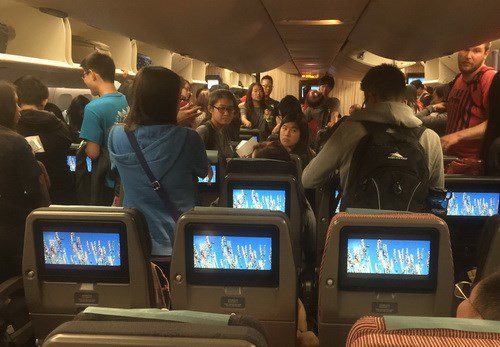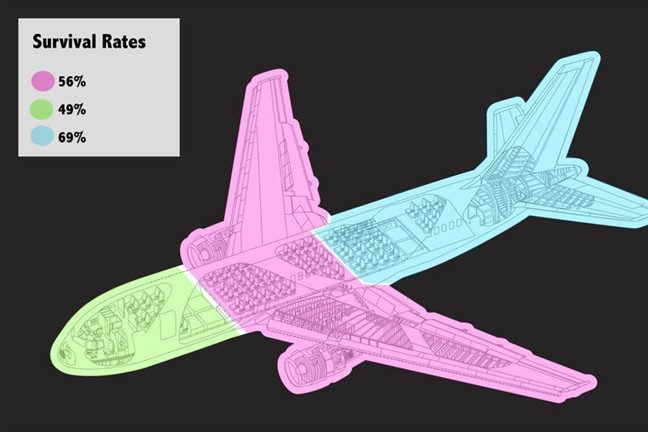If traveling by plane, do you know which seat is the safest? Experts indicate that there are certain areas on the aircraft with the highest survival rates.
Which location on the plane is the safest?
According to published statistics, airplanes are the safest mode of transportation, with the lowest accident rates. However, the consequences and impacts of airplane accidents can be significant, so all scenarios must be considered for precautionary measures.
So, if an incident occurs, which passengers have the best chance of escaping? Are the seats in first class the most secure?
To answer the question “Which position is the safest on a plane?”, scientists from the University of Greenwich (UK) conducted research on 2,000 passengers who survived 105 airplane accidents worldwide.
In an article published at the end of June, Time magazine (USA) reported that the above statistics were based on a study of airplane accidents over the past 35 years conducted by the magazine itself.

Passengers on a flight with China Airlines preparing to disembark – (Photo: Hoàng Uy)
By reviewing data on both fatalities and survivors from airplane accidents from the Federal Aviation Administration (FAA), Time found that seats in the rear of the plane had a mortality rate of 31%, compared to 44% for seats in the fuselage and 51% for seats in the front.
Additionally, the American magazine discovered that middle seats in the rear of the plane had the lowest mortality rate at 28% compared to other positions in an aircraft.
The seats with the highest mortality rate were those in the aisle seats of the fuselage, reaching a rate of 44%, according to Time.
However, the magazine also cautiously added that the likelihood of death in an airplane accident depends more on the circumstances surrounding the accident than on where passengers are seated.

Results from Popular Mechanics: Survival rates in rear seats are highest at 69%; middle seats at 56%; and front seats at 49%.
“If the rear of the plane is the most affected during a bad situation, then those seated in the fuselage or the front may be safer than passengers sitting in the rear,” Time commented.
“We observed that survival cases happened randomly in some accidents; thus, those who died were mixed in with those who were lucky enough to survive. It is for this reason that the FAA and aviation safety experts warn that there is no seat that is the safest on a plane,” the American magazine noted. The risk of survival in these accidents is almost zero. Therefore, every safe position mentioned is only relatively safe.
Nevertheless, Time asserts one thing is certain – air travel is a very safe mode of transportation and has become increasingly safer in recent decades.
“This is especially true when compared to other means of transportation. The mortality rate when traveling by car is 1 in 112, walking is 1 in 700, and biking is 1 in 900. For airplanes, this rate is only about 1 in 8,000”, Time reported.
Don’t overlook the safety instructions
Associate Professor Anthony Brickhouse, Director of the Forensic Laboratory of Aviation at Embry-Riddle Aeronautical University, Daytona Beach (USA), and aviation industry experts recommend that passengers should pay more attention to the safety instructions of airlines. He notes that most passengers, especially those who fly frequently, tend to ignore these details.
Before flying, flight attendants often remind passengers to fasten their seatbelts while seated and to locate the nearest exit in case of an emergency. However, Brickhouse observes that in emergencies, many passengers tend to run towards the front exit rather than finding the nearest door.
“Psychologically, people prefer to exit the plane the way they entered. We need to be alert, attentive, and aware of what is happening,” the Associate Professor analyzed.
Another tip for escaping is to count the rows to the nearest exit. Professor Graham Braithwaite at Cranfield University (UK) notes that some airlines suggest passengers actively count the rows to the exit, even if the exit is directly behind their seats.
He recounts the story of a British Airtours plane fire at Manchester Airport (UK) in 1985. The last passenger to escape the fire mentioned that he always counted the rows until he reached the nearest exit. When smoke filled the cabin, this habit helped him locate the emergency exit and safely leave the aircraft.
When traveling, Braithwaite prefers to sit in an aisle seat near the exit. During an evacuation in an emergency, he advises everyone to listen to the flight attendants as they are instructed by the pilot on the safest exits for evacuation. Flight attendants are also responsible for determining the right time and safe position to open the emergency exits.


















































